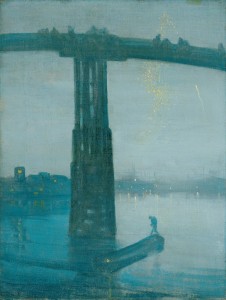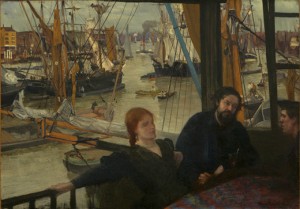Whistler in Andover: ‘An American in London’
Nocturne: Blue and Gold—Old Battersea Bridge (1872-75)
James Abbott McNeill Whistler (1834-1905) was nine years old when his family left Lowell and traveled to St. Petersburg, Russia, where his father helped the Czar build a railroad. In Lowell, his father, George Washington Whistler, and mother, Anna Matilda McNeill, lived at 243 Worthen St., the house provided to the Chief Engineer of the Locks & Canal Company. That’s where he was born. That’s where “Whistler met his mother,” as the joke goes. After Whistler achieved fame, he would deny his roots, telling people that he was born in Russia or even Baltimore. As readers of this blog know, however, Lowell people can be tough, and they never let him get away with that lie. The Lowell Art Association (1878), the oldest incorporated art association in the county, purchased the house in 1908. Today it is the home of the Whistler House Museum of Art.
Whistler lived most of his life in London, along the Thames River, and his fascination with the river is the subject of the featured exhibition at the Addison Gallery of American Art at Phillips Academy in Andover through April 13. The paintings, etchings, and other works brought together for this show make a strong case for the power of place in an artist’s imagination. Images of riverscapes, bridges, “watermen,” and buildings on the banks have been gathered from museums in London, Paris, New York City, Washington, D. C., and elsewhere. Whistler gives us what he saw every day, the world outside his window. Many of the artworks were new to me. To see them in a tightly organized arrangement, linked thematically, added layers of additional meaning and made them a pleasure to see. This exhibit is more like a satisfying short story than a novel in which you lose yourself—and a gigantic Whistler retrospective would be the kind of exhibit in which you might be overwhelmed by one masterwork after another. Instead, you encounter the classic Norturne: Blue and Gold–Old Battersea Bridge (1872-75) with plenty of aesthetic room around it, as well as seeing it in the context of Whistler’s fascination with the structure. The viewer also can spend time with immensely detailed etchings for which Whistler was well known. Wall labels explain the technique and process of making these works, which takes something of the engineer’s DNA that he may have gained from his father.
The Boston Globe’s prize-winning art critic Sebastian Smee raved about the exhibition. I’ve never seen so many people in the Addison on a Sunday afternoon as I did this past weekend. A related exhibit, “Industrial Strength,” is a draw itself. A number of photographs of Lawrence, Mass., are included, which was good to see in Andover.
The Addison is on Rte. 28, Main St., on the Phillips campus in Andover. Museum hours are Tues-Sat, 10 am to 5 pm, and Sun 1 to 5 pm. Admission is free. For more information, visit www.addisongallery.org
Wapping (1860-64) [Wapping is the name of an area on the docks]

